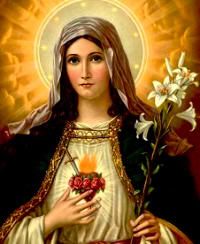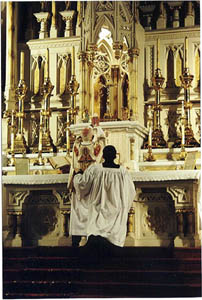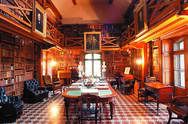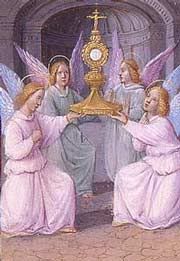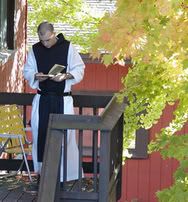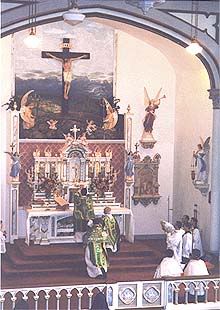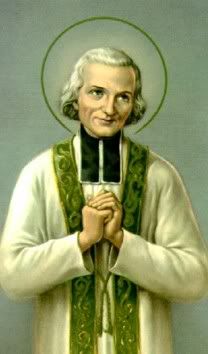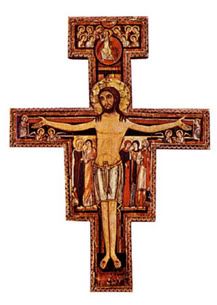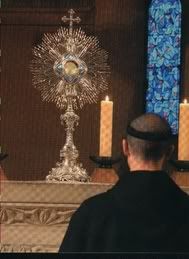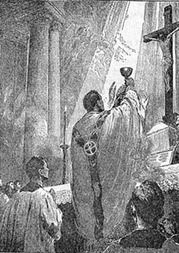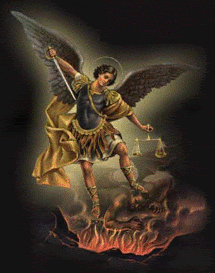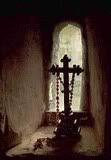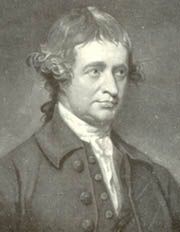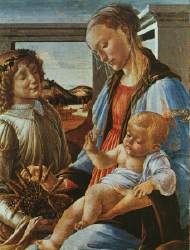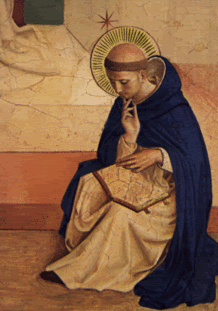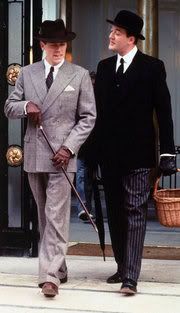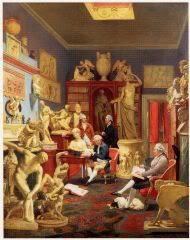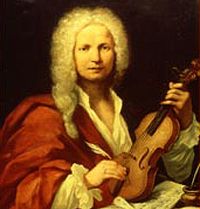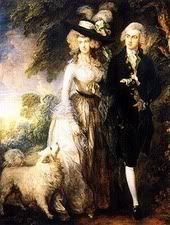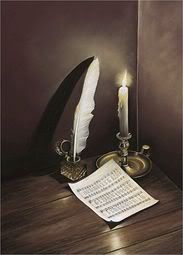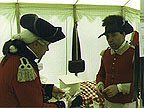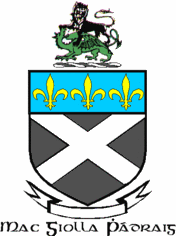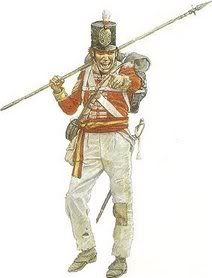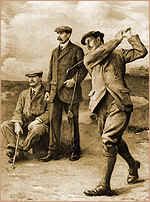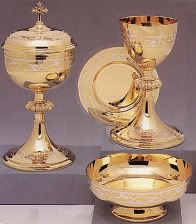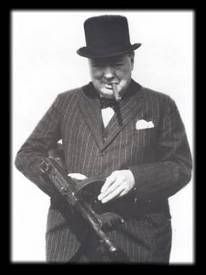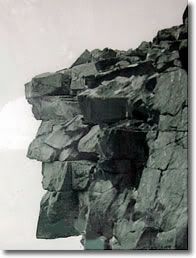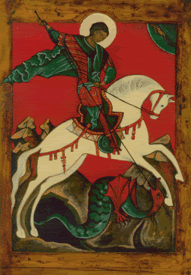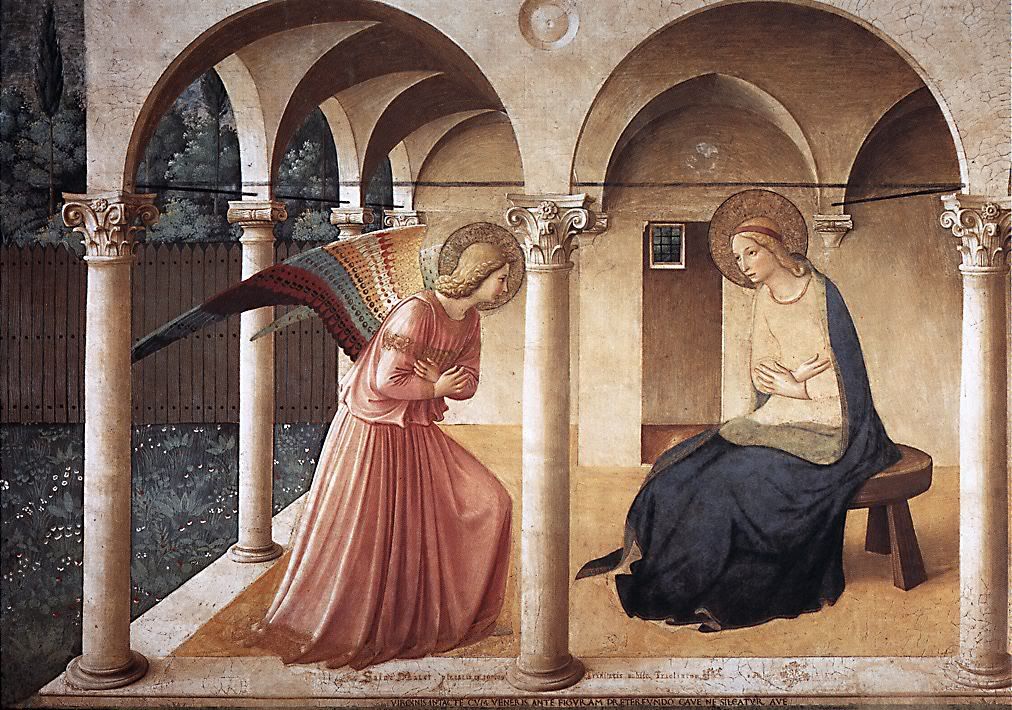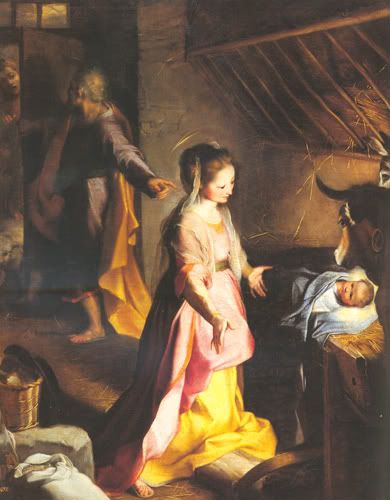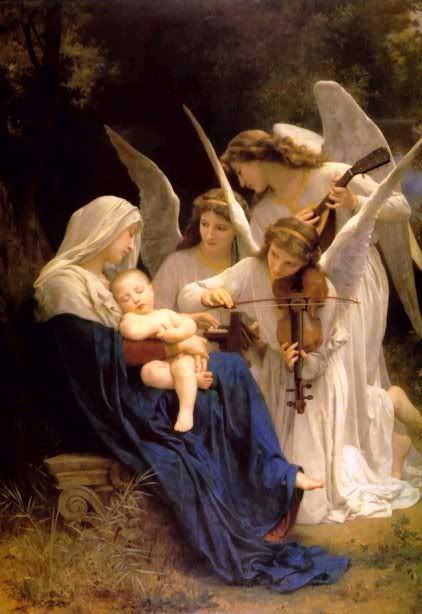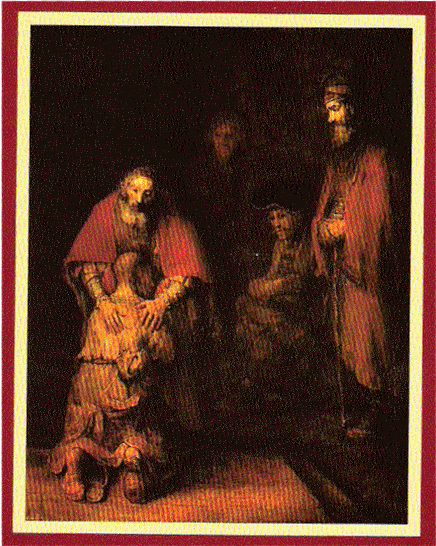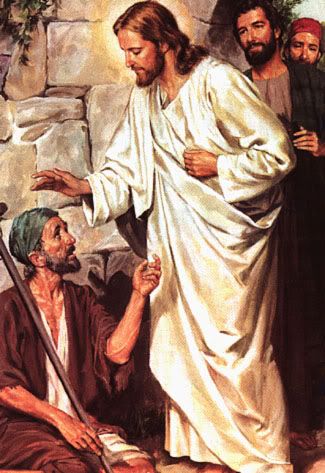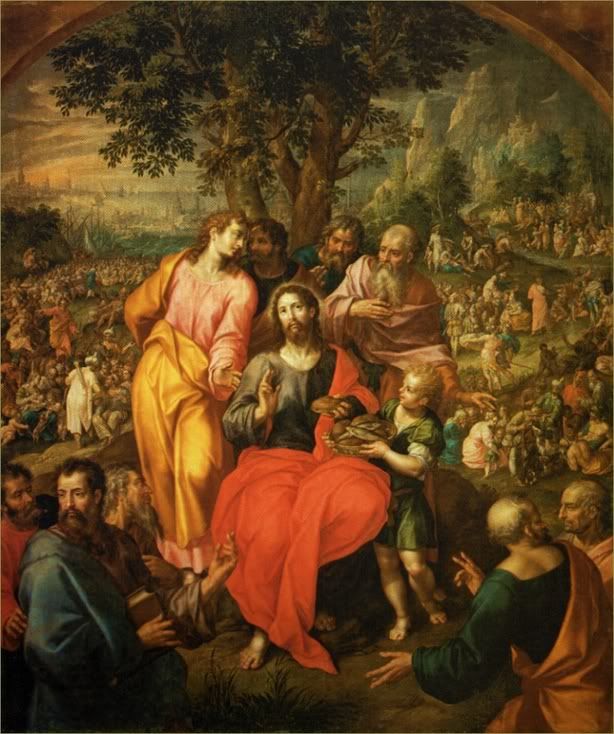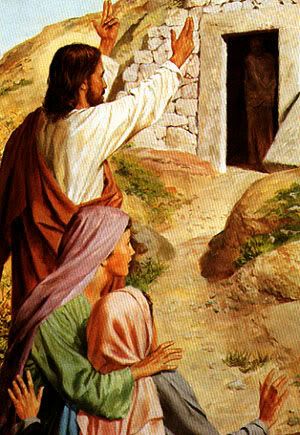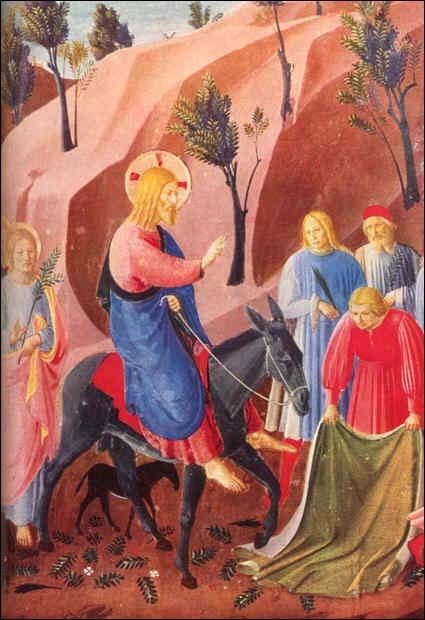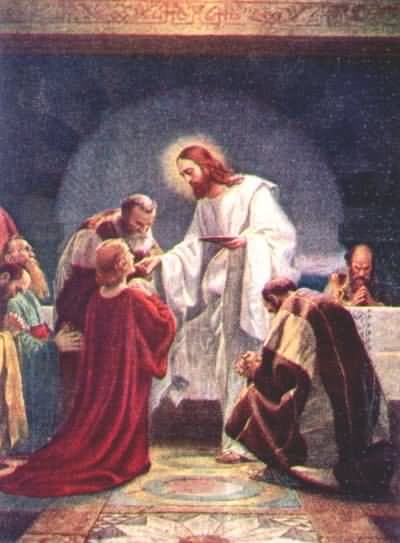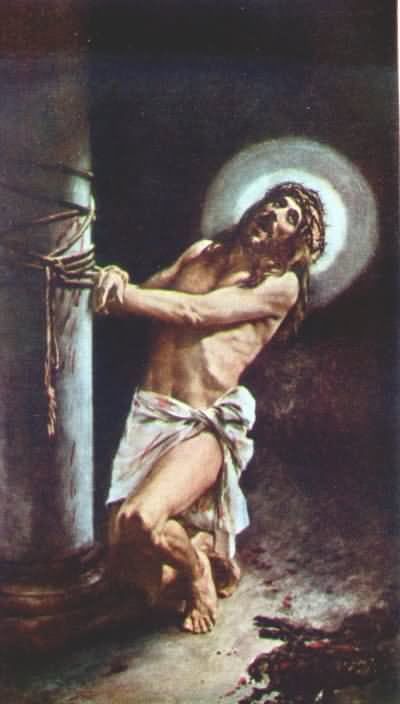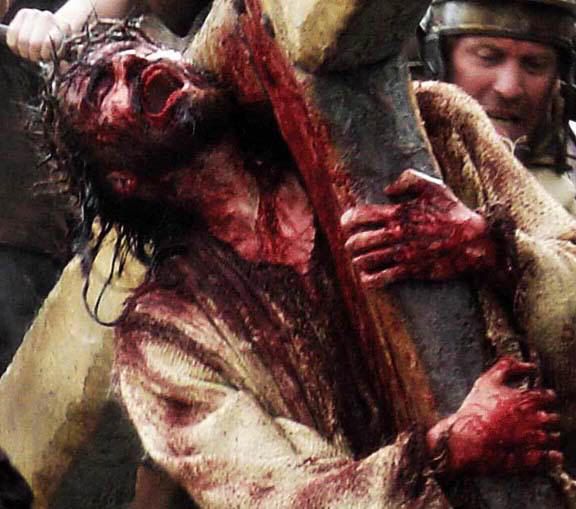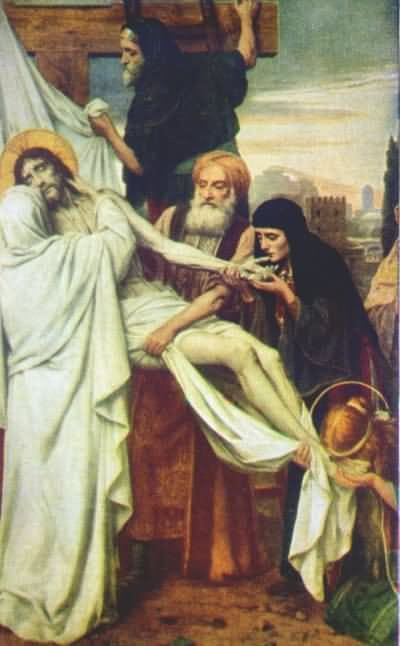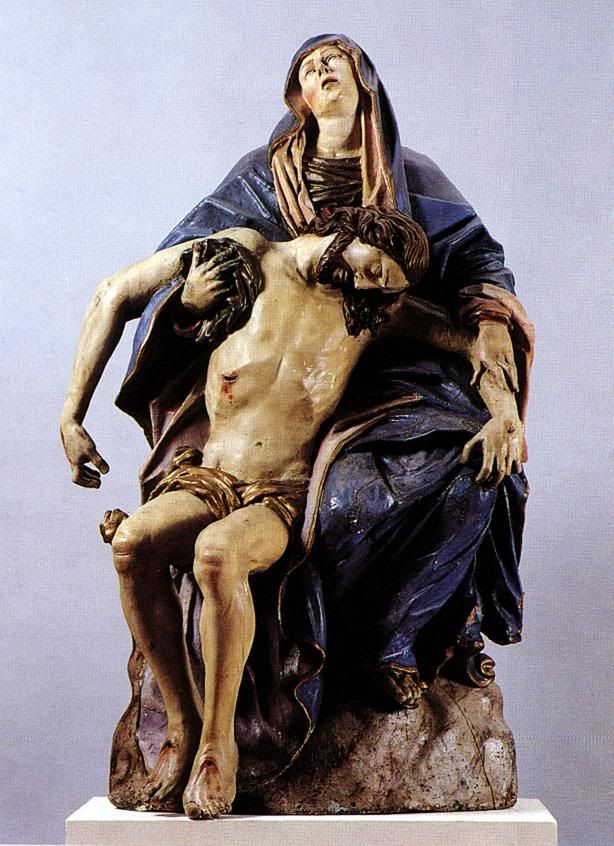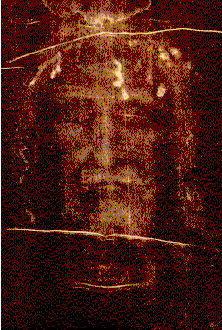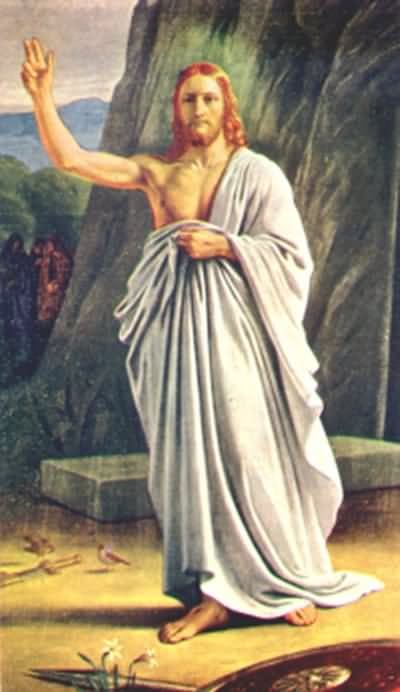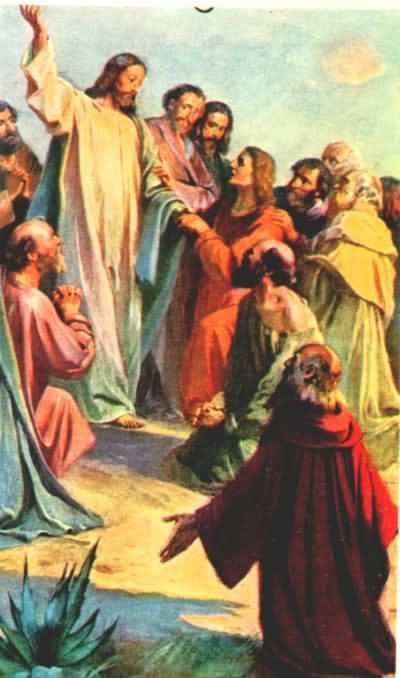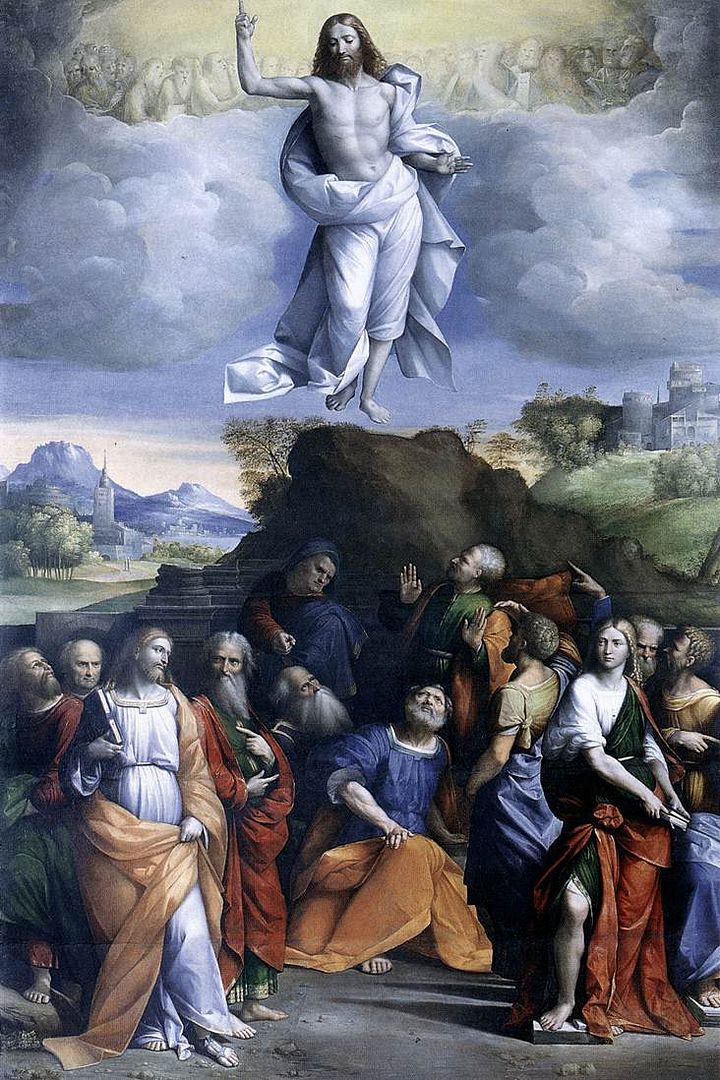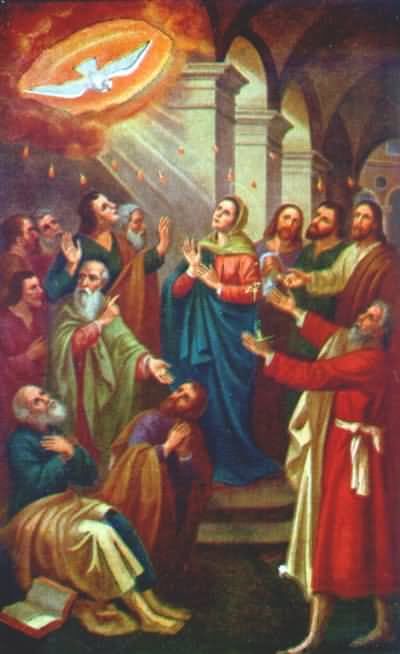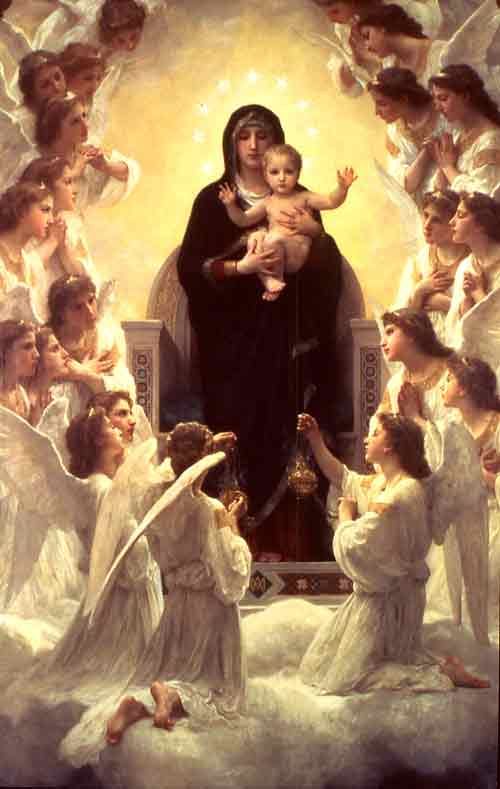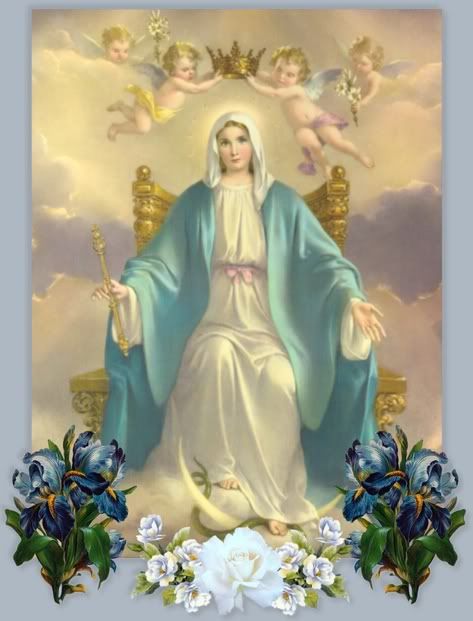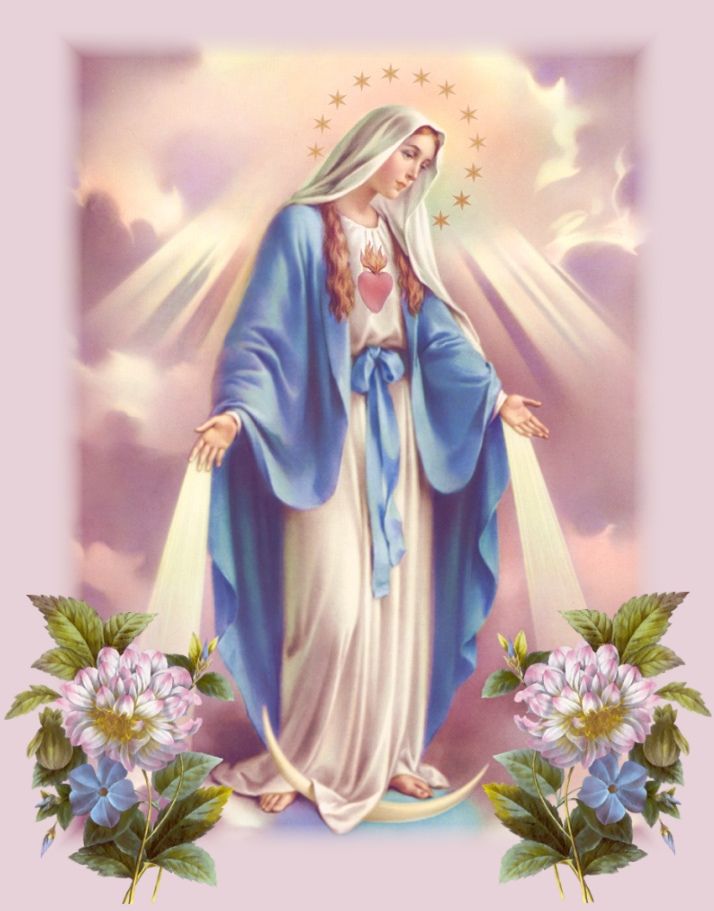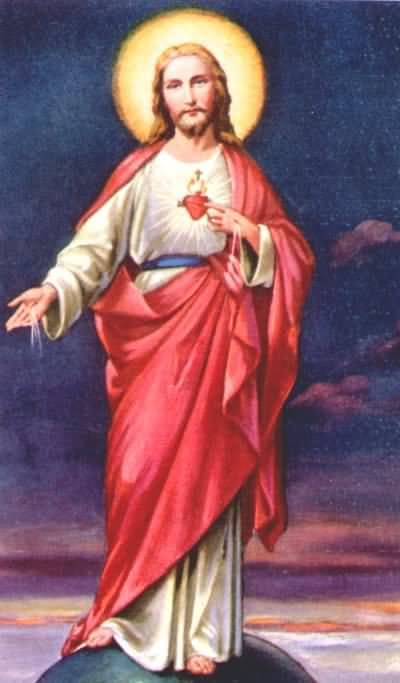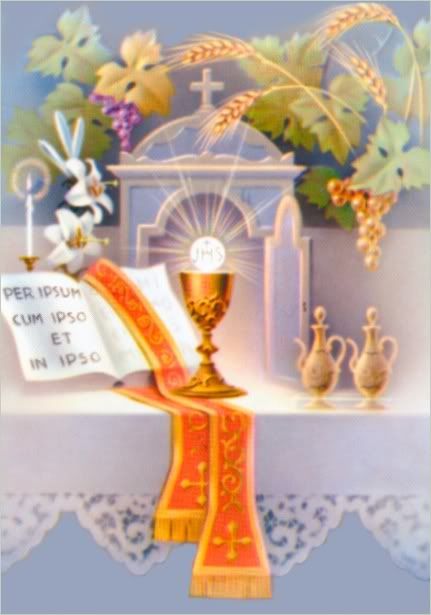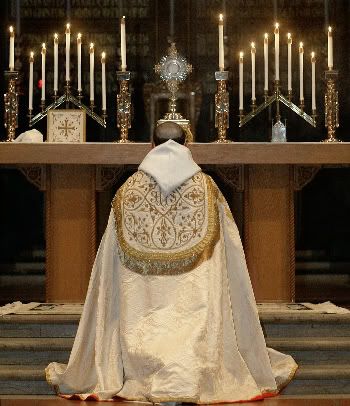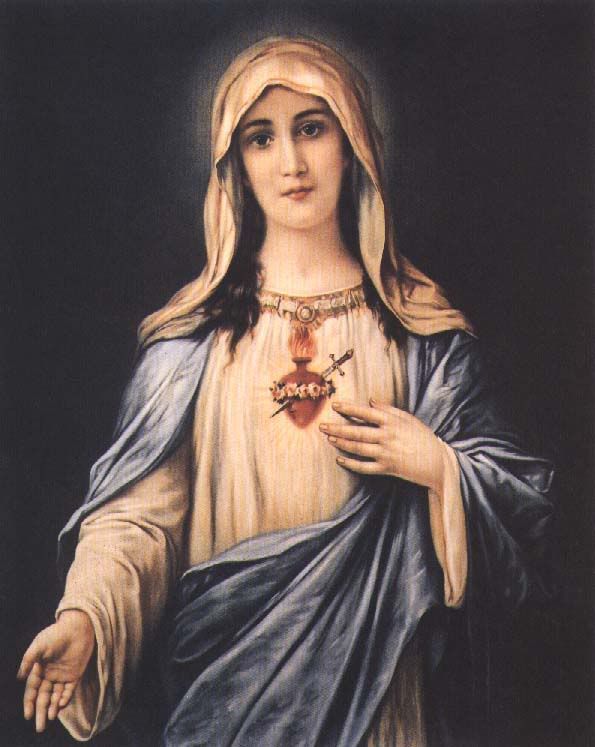Saturday, October 29, 2005
Salem: World Halloween Capital
There is a lot that is wrong with Salem and its celebration of Halloween. It is far too accomodating to Wicca and other New Age cults that have absolutely nothing to do with what happened in Salem Village and Salem Town in 1692. That is because the people hanged as witches were completely innocent. They were not witches because there were no such things then. There was a lot of hysteria about witchcraft, but no actual witches in America or Europe.
And the people who call themselves that now are playing at the occult. They are no more witches than George W. Bush is. They have no powers, and the spells and potions they sell are pure nonsense, just tourist junk. They are misguided people, ex-hippies, goths, punks, lesbians, bikers: people who don't fit in and are not interested in genuine religion who have glommed onto a fad to make a buck telling fortunes to people with a few dollars they want to foolishly part with.
For more than 100 years, Salem has tried to cash in on its reputation. Halloween in Salem lasts most of October. The crowds get bigger and bigger, and every year, it seems, there is nonsense about the Knights of Columbus foolishly renting their hall for some occult gathering. Halloween in Salem attracts thousands upon thousands of tourists. They are treated to an array of haunted houses, hearse tours, ghost story tours, street vendors, and a carnival-type atmosphere, whose closest thing is Mardi Gras in New Orleans.
When I lived in downtown Salem, there were literally fifty thousand people milling around outside my windows on Halloween night, and I had the perfect ringside seat for the spectacle. Of course, since Salem is not an easy city to get into because the main highways bypassed Salem, that means traffic coming in the weekend of Halloween, when the weather is nice (it is snowing lightly right now, and I doubt there is much of a problem today) is pure gridlock. But if I stayed home, there was all the fried dough and hot mulled cider a fellow could want. Plus jugglers, music acts, and a vast array of cleverly costumed folk milling around.
But that aside, Salem in October is a very cool place. The haunted houses are not for me, except the historic buildings, where ghost stories are plausible. There are three or four places in particular that are very evocative of the mood of the season of the dead, or at least what comes to my mind when I think about the dying time of the year, the season when we especially pray for our dead.

Gallows Hill. Site of the hanging tree where 19 women and men where executed as witches on what we would consider non-credible evidence in 1692.
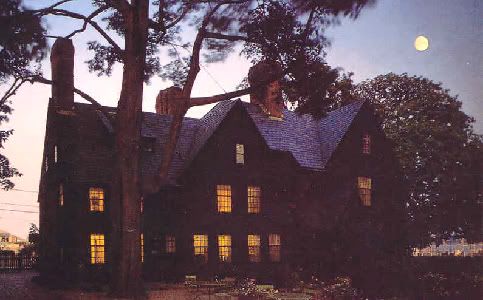
The House of the Seven Gables at night. As it was owned by a cousin of Nathaniel Hawthorne, he was a frequent visitor here, and set his classic novel here. Yes, there is a hidden staircase that was probably used to hide runaway slaves as part of the Underground Railroad.

Halloween-themed painting used as a postcard of the House of the Seven Gables. Yes, the 17th century ship captain's mansion house does evoke thoughts of Halloween. For me, Halloween is a time for play and traditional customs. And the eerie tree, glowing jack-o-lanterns, and made-up witches all are a legitimate part of Halloween.
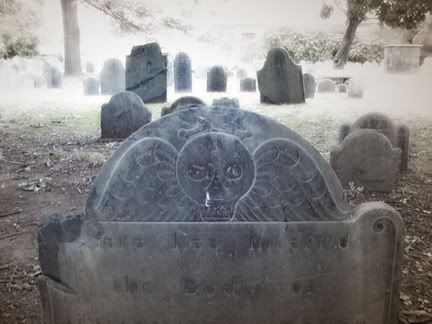
The Charter Street Burial Ground is one of the oldest graveyards in the US, and contains a wealth of atmosphere, as well as the graves of a Mayflower passenger, and Samuel McIntire, the federal period architect who gave Salem its distinctive look during its heyday as the richest town in America.






This is the second-most interesting tree I have ever seen. The most interesting is at Glen Magna in Danvers. I used to smoke cigars under this one when I lived a block from this graveyard.

Kind of spooky, eh? The same tree, probably taken in November, once all the leaves were off. The trees in Boston and Salem are just changing now, and are still full of leaves.

Salem Common in fall. Another favorite cigar-smoking haunt of mine, though a little further from my old place than Charter Street Burial Ground.
See what I wrote last year about Hallowmas Week.
And the people who call themselves that now are playing at the occult. They are no more witches than George W. Bush is. They have no powers, and the spells and potions they sell are pure nonsense, just tourist junk. They are misguided people, ex-hippies, goths, punks, lesbians, bikers: people who don't fit in and are not interested in genuine religion who have glommed onto a fad to make a buck telling fortunes to people with a few dollars they want to foolishly part with.
For more than 100 years, Salem has tried to cash in on its reputation. Halloween in Salem lasts most of October. The crowds get bigger and bigger, and every year, it seems, there is nonsense about the Knights of Columbus foolishly renting their hall for some occult gathering. Halloween in Salem attracts thousands upon thousands of tourists. They are treated to an array of haunted houses, hearse tours, ghost story tours, street vendors, and a carnival-type atmosphere, whose closest thing is Mardi Gras in New Orleans.
When I lived in downtown Salem, there were literally fifty thousand people milling around outside my windows on Halloween night, and I had the perfect ringside seat for the spectacle. Of course, since Salem is not an easy city to get into because the main highways bypassed Salem, that means traffic coming in the weekend of Halloween, when the weather is nice (it is snowing lightly right now, and I doubt there is much of a problem today) is pure gridlock. But if I stayed home, there was all the fried dough and hot mulled cider a fellow could want. Plus jugglers, music acts, and a vast array of cleverly costumed folk milling around.
But that aside, Salem in October is a very cool place. The haunted houses are not for me, except the historic buildings, where ghost stories are plausible. There are three or four places in particular that are very evocative of the mood of the season of the dead, or at least what comes to my mind when I think about the dying time of the year, the season when we especially pray for our dead.

Gallows Hill. Site of the hanging tree where 19 women and men where executed as witches on what we would consider non-credible evidence in 1692.

The House of the Seven Gables at night. As it was owned by a cousin of Nathaniel Hawthorne, he was a frequent visitor here, and set his classic novel here. Yes, there is a hidden staircase that was probably used to hide runaway slaves as part of the Underground Railroad.

Halloween-themed painting used as a postcard of the House of the Seven Gables. Yes, the 17th century ship captain's mansion house does evoke thoughts of Halloween. For me, Halloween is a time for play and traditional customs. And the eerie tree, glowing jack-o-lanterns, and made-up witches all are a legitimate part of Halloween.

The Charter Street Burial Ground is one of the oldest graveyards in the US, and contains a wealth of atmosphere, as well as the graves of a Mayflower passenger, and Samuel McIntire, the federal period architect who gave Salem its distinctive look during its heyday as the richest town in America.






This is the second-most interesting tree I have ever seen. The most interesting is at Glen Magna in Danvers. I used to smoke cigars under this one when I lived a block from this graveyard.

Kind of spooky, eh? The same tree, probably taken in November, once all the leaves were off. The trees in Boston and Salem are just changing now, and are still full of leaves.

Salem Common in fall. Another favorite cigar-smoking haunt of mine, though a little further from my old place than Charter Street Burial Ground.
See what I wrote last year about Hallowmas Week.
Friday, October 28, 2005
Evelyn Waugh Would Be 102 Today
My New England Tales of the Odd
Oak Hill
How Devil's Dishful Pond Got Its Name
A Gentle Good-bye
The Haunted Rectory
Just A Reminder
I'm working on a new one on the Salem Witch Trials. I hope to have it up over the weekend.
How Devil's Dishful Pond Got Its Name
A Gentle Good-bye
The Haunted Rectory
Just A Reminder
I'm working on a new one on the Salem Witch Trials. I hope to have it up over the weekend.
Catholic Ghost Stories
Taken from Hell plus How to Avoid Hell by Fr. FX Schouppe, S.J. and Thomas A. Nelson. (TAN Books & Publishers, Inc., 1989)
The following is from So High the Price by Father P.T. Kelly STL, Daughters of Saint Paul, 1968. It is an incident from the life of St. Francis Jerome, which took place in Naples in 1707.


From the same source, quoting St. Antoninus:
A holy priest was exorcizing a demoniac, and he asked the demon what pains he was suffering in Hell. "An eternal fire," he answered, "an eternal malediction, an eternal rage, and a frightful despair at being never able to gaze upon Him who created me." "What would you do to have the happiness of seeing God?" "To see Him but for one moment, I should willingly consent to endure my torments for 10,000 years. But vain desires! I shall suffer forever and never see Him!"
On a like occasion, the exorcist inquired of the demon what was his greatest pain in Hell. He replied with an accent of indescribable despair: "Always, always! Never; never!"
Father Nieremberg, in his work "The Difference between Time and Eternity", speaks of an unfortunate sinner, who, as the result of his evil ways, had lost the Faith. His virtuous wife exhorted him to return to God and reminded him of Hell, but he would answer obstinately: "There is no Hell." One day his wife found him dead, and strange circumstance, he held in his hand a mysterious paper on which in large characters was traced this terrifying avowal: "I now know that there is a Hell!"
Mgr. de Segur relates a second fact, which he regards as alike free from doubt. He had learned it in 1859, of a most honorable priest and superior of an important community. This priest had the particulars of it from a near relation of the lady to whom it had happened. At that time, Christmas Day, 1859, this person was still living and little over forty years.
She chanced to be in London in the winter of 1847-1848. She was a widow, about twenty nine years old, quite rich and worldly. Among the gallants who frequented her salon, there was noticed a young lord, whose attentions compromised her extremely and whose conduct, besides, was anything but edifying!
One evening, or rather one night, for it was close upon midnight, she was reading in her bed some novel, coaxing sleep. One o'clock struck by the clock; she blew out her taper. She was about to fall asleep when, to her great astonishment, she noticed that a strange, wan glimmer of light, which seemed to come from the door of the drawing-room, spread by degrees into her chamber, and increased momentarily. Stupified at first and not knowing what this meant, she began to get alarmed, when she saw the drawing-room door slowly open and the young lord, the partner of her disorders, enter the room. Before she had time to say a single word, he seized her by the left wrist, and with a hissing voice, syllabled to her in English: "There is a Hell!" The pain she felt in her arm was so great that she lost her senses.
When, half an hour after, she came to again, she rang for her chambermaid. The latter, on entering, noticed a keen smell of burning. Approaching her mistress, who could hardly speak, she noticed on her wrist so deep a burn that the bone was laid bare and the flesh almost consumed; this burn was the size of a man's hand. Moreover, she remarked that, from the door of the salon to the bed, and from the bed to that same door, the carpet bore the imprint of a man's steps, which had burned through the stuff. By the directions of her mistress, she opened the drawing-room door; there, more traces were seen on the carpet outside.
The following day, the unhappy lady learned, with a terror easy to be divined, that on the very night, about one o'clock in the morning, her lord had been found dead-drunk under the table, that his servants had carried him to his room, and that there he had died in their arms.
The following is from So High the Price by Father P.T. Kelly STL, Daughters of Saint Paul, 1968. It is an incident from the life of St. Francis Jerome, which took place in Naples in 1707.

One day, the servant of God preached in front of the home of one of those unfortunate women. Rather than repent, however she did everything she could to interrupt him, even letting loose great yells, but nothing she did suceeded to distract the attention of our saint, who continued his sermon until its end.
Some days later, Father Francis passed in front of the same house, and seeing it closed, asked those who were nearby: "What happened to Catherine?" That was the name of the unhappy woman.
She died suddenly yesterday," they answered.
"Dead!" exclaimed the Saint. "Let us go and see her."
He entered the home, and climbed the stairs. There he saw the body laid out according to the custom. Then, in the midst of the profound silence that reigned over the place, in spite of the large number of spectators, he exclaimed: "Tell me, Catherine, what has been done with thy soul?"
He asked this question twice without getting an answer; but, when he repeated it a third time, in a tone of authority, the dead woman opened her eyes, moved her lips in sight of everyone and, with a weak voice that seemed to come out of a great depth, answered: "In hell; I am in hell!"
Everyone left frightened and, upon withdrawing, the Saint repeatedly said: "In hell! In hell! All-powerful God, terrible God! In hell!"
The event and words of the saint caused such an impression that many did not dare return home without first going to confession.

From the same source, quoting St. Antoninus:
A young man from a good family, who had unfortunately hidden a mortal sin in confession at the age of sixteen, continued going to Communion, always putting off, week by week, month by month, the confession seemingly so impossible. Tormented constantly and gulping down the remorse that ate his soul, he thought to make up by doing great acts of penance. Still, his conscience would not let him rest.
"I'll join a monastery," he reasoned. "There at last I will reveal all and will do penance for my sins."
But unfortunately he was welcomed as a youth of holy life and therefore the voice of conscience was overcome by shame. Once again, he put off making that 'sincere' confession. One, two, and three years passed by. Still his nerve failed, and finally upon falling sick, the poor man said to himself, "Now is my chance to reveal everything and make a general confession before dying." But even this time instead of manifesting his sins, he knowingly hid them, so engrained was he in pride. "Tomorrow I will ask for the priest and make a good confession," he told himself. But a high fever brought on delirium and he died in that wretched state without gaining consciousness.
His confreres, never guessing his unhappy end, were filled with veneration for the seemingly virtuous religious. With great reverence, they brought his coffin into the chapel.
Just minutes before the funeral, one of his confreres, about to ring the community bell summoning all to the funeral--stopped in alarm and fell on his knees at a terrible sight. In front of him stood a religious, clothed in red-hot chains. "I am in hell, the reprobate cried, "do not pray for me." It was the deceased monk. Then he related the story of his cursed shame and the litany of sacrileges. The vision faded away. Only the terrible stench remained which filtered throughout the whole monastery.
Saints Simon and Jude

Saint Jude
Saint Jude, of course, is the patron of lost and hopeless causes.
Here is the novena to Saint Jude
Holy Saint Jude, Apostle and Martyr, great in virtue and rich in miracles, near kinsman of our Lord Jesus Christ, faithful intercessor of all who invoke thy special patronage in time of need. To thee I have recourse from the depths of my heart and humbly beg thee, to whom God has given such great power, to come to my assistance. Help me in my present and urgent petition. In return I promise to make thy name known and cause thee to be invoked. Saint Jude, pray for us and all who invoke thine aid.
Amen.

Saint Simon the Zealot
The Golden Legend has this to say about the lives of these two Apostles.
Thursday, October 27, 2005
What Priest Shortage?
An Idea
I know All Saints' Day covers this, but why not a seperate feast on, say, November 5th honoring all martyrs.
There was, at one time, a Martyrs' Day. Then All Saints' Day came along and eclipsed it. But with so many martyrs piled up now, from the various Roman persecutions, the Arians, the protestant rebellions, the French Revolution, the Spanish Civil War, the various communist regimes, the martyrs who were killed as missionaries in Asia or early America, why not add a new feast just for them, in the month of November in proximity to the feasts of All Souls and All Saints?
I like the idea of November 5th, because it will give English Catholics (who already outnumber CofE members in the England itself, as well as the UK as a whole) something to celebrate on that day, and assimilate the existing protestant Guy Fawkes Night.
There was, at one time, a Martyrs' Day. Then All Saints' Day came along and eclipsed it. But with so many martyrs piled up now, from the various Roman persecutions, the Arians, the protestant rebellions, the French Revolution, the Spanish Civil War, the various communist regimes, the martyrs who were killed as missionaries in Asia or early America, why not add a new feast just for them, in the month of November in proximity to the feasts of All Souls and All Saints?
I like the idea of November 5th, because it will give English Catholics (who already outnumber CofE members in the England itself, as well as the UK as a whole) something to celebrate on that day, and assimilate the existing protestant Guy Fawkes Night.
Saluting A Great American Catholic 20th Century Artist
Ariel Agemian
His work illustrates four books published by the Confraternity of the Most Precious Blood in the 1940s and 1950s:
My Imitation of Christ
My Daily Prayerbook
My Meditations On the Gospels
My Mass Book

His most famous single painting is the portrait of our Lord based on the Holy Shroud of Turin.

This image, very well known among Latin Mass aficianados, is from his illustrations for My Imitiation of Christ.

Another from the same source.


Two others from the same source scanned in by TCR News
His work illustrates four books published by the Confraternity of the Most Precious Blood in the 1940s and 1950s:
My Imitation of Christ
My Daily Prayerbook
My Meditations On the Gospels
My Mass Book

His most famous single painting is the portrait of our Lord based on the Holy Shroud of Turin.

This image, very well known among Latin Mass aficianados, is from his illustrations for My Imitiation of Christ.

Another from the same source.


Two others from the same source scanned in by TCR News
The Chaplet of the Dead
The traditional Chaplet of the Dead, or Beads of the Dead, is said on a 4-decade rosary (though you can adapt and use a regular set of beads). The 4 decades represent the 40 hours our Lord spent in the Harrowing of Hell.
The Beads of the Dead begin and end with the De Profundis, Psalm 129/130.
On the introductory beads the usual Pater, Aves, and Doxologia Minor.
On the large beads, starting with the medal, say the Acts of Faith, Hope, and Charity.
On the small beads, say "Sweet heart of Mary, be my salvation."
At the end of each decade, say "Eternal Rest Grant unto (him/her)
and let the perpetual light shine upon (him/her). May (he/she) rest in peace."
After completing 4 decades, say the De Profundis again, and add the folloing:
V. Eternal rest grant unto (him/her), O Lord.
R. And let perpetual light shine upon (him/her).
V. May (he/she) rest in peace.
R. Amen.
V. May (his/her) soul and the souls of all the faithful departed,
through the mercy of God, rest in peace.
R. Amen. +
May the love of God and the peace of the Lord Jesus Christ bless us and console us and gently wipe every tear from our eyes.
In the name of the Father,
and of the Son,
and of the Holy Ghost.
R. Amen.

Memento Mori
The Beads of the Dead begin and end with the De Profundis, Psalm 129/130.
On the introductory beads the usual Pater, Aves, and Doxologia Minor.
On the large beads, starting with the medal, say the Acts of Faith, Hope, and Charity.
On the small beads, say "Sweet heart of Mary, be my salvation."
At the end of each decade, say "Eternal Rest Grant unto (him/her)
and let the perpetual light shine upon (him/her). May (he/she) rest in peace."
After completing 4 decades, say the De Profundis again, and add the folloing:
V. Eternal rest grant unto (him/her), O Lord.
R. And let perpetual light shine upon (him/her).
V. May (he/she) rest in peace.
R. Amen.
V. May (his/her) soul and the souls of all the faithful departed,
through the mercy of God, rest in peace.
R. Amen. +
May the love of God and the peace of the Lord Jesus Christ bless us and console us and gently wipe every tear from our eyes.
In the name of the Father,
and of the Son,
and of the Holy Ghost.
R. Amen.

Memento Mori
White Sox Win the World Series
Like the equally deprived and snake-bitten Red Sox last year, they brought their October Classic woes to a convincing halt with a 4-game sweep.
Congratulations to the White Sox and their fans!
Congratulations to the White Sox and their fans!
Irish Halloween Foods
We would not want you to have to celebrate Halloween, which is essentially Irish in derivation, without a couple of authetic recipes for the occasion.
Let's start with Barmbrack, the fruitcake traditionally served for Halloween night. You need a pudding (English and Irish slang for dessert) for Halloween, and barmbrack is the traditional choice. Since the night of October 31st is a traditional time for fortune-telling nonsense, a ring is included in the barmbrack. Whoever finds it will allegedly be married in the next year. This is similar to the hiding of charms that allegedly fortell the future in English Twelfth Cakes.
Barmbrack
2 1/2 cup Mixed dry fruit--currants, dates & raisins
1 cup Boiling black tea
1 Egg, slighty beaten
1 Mixed spice
4 tsp Orange Marmalade
1 1/3 cup superfine/castor sugar
2 1/2 cups Self-raising flour
1 ring wrapped in wax paper (optional)
Place dried fruit in a bowl, cover with the hot tea and let soak overnight.
The next day, add the remaining ingredients. and mix well. Add ring wrapped in greaseproof paper(optional).
Preheat oven to 375 F. Pour batter into greased 7" square pan and bake in the center of oven for 1 1/2 hrs.
Let cool in the pan on a wire rack. Slice and serve buttered with tea.
Champ
Want something to serve Halloween night that is not loaded with sugar? Before the kids gourge on trick-or-treat candy and caramel apples, get something with a little substance into them. If it is cold in your part of the country this Halloween night, they'll need something that will stick to their ribs. Try Champ.
Champ is essentially rich-man's mashed spuds. It is traditionally served in Ireland as an alternative to Colcannon on Halloween night. Colcannon often has cabbage, which I dislike. Champ lacks the offending greenery.
You need:
8 large russets (I like Yukon Gold)
2 cups heavy cream
1/2 pound butter
fresh or dried chives to taste
fried or dried onions to taste
salt to taste
freshly grated pepper to taste
1/4 pound butter
1 pound Irish back bacon
Cut a strip 1/2 inch wide along the circumference of each of the spuds. This gives them better flavor, and allows for easier peeling once they have been boiled. Then boil them in their jackets.
Fry up the Irish back bacon. Irish back bacon is more like cured pork than our smoked breakfast bacon. Once the back bacon is done, dry it off with paper towels, and cut off and remove the fat and dice up the choice pieces.
Peel the spuds, and place them in a large bowl and mash them with the cream, the 1/2 pound of butter (or more, if you like) chives, onions, salt and pepper. Mix them up and bring the spuds to a consistency you like. I prefer firm, smooth, and very creamy.
Add in the back bacon and stir.
To serve, mound up the champ on each plate, and hollow out a crater at the top. Here, put in the additional butter sliced up so so that it melts. As you eat forkfuls of champ, dip them in the crater of butter. Sinfully rich and delicious!
I also like this on Saint Patrick's Day.
Now suppose you want to bring out the deep-fat fryer and fry up those russets, instead. Well, french fries are best dipped in something mayonnaisey, right. Here is an Irish dip:
Mustard Mead Dip
1/2 cup mayonnaise
1/4 cup Lakeshore Wholegrain Mustard with Bunratty Meade
1 teaspoon chopped fresh dill
In a small bowl, combine the mayonnaise, mustard, and dill and stir to smooth. Dip you home-made fries to your heart's content. Very hearty and tasty.
While we are talking about sinfully rich Irish foods,
Dubliner Cheese Tart
Pastry
3/4 cup all-purpose flour, sifted
Pinch of salt
5 tablespoons Kerrygold Irish butter, cut into small pieces
3 tablespoons cold water
Filling
1 tablespoon Kerrygold Irish butter
1 small onion, chopped
1 clove garlic, minced
3 slices Irish back bacon, cut into strips
8 button mushrooms, sliced
10 cherry tomatoes, halved
6 ounces Dubliner cheese, grated
1 cup milk
3 eggs, beaten
1 tablespoon Italian seasoning
1 teaspoon wholegrain mustard
Salt and freshly ground black pepper
Preheat oven to 400° F.
Combine the flour and salt in a bowl, then with a pastry cutter, two forks, or your fingers, work in the butter until the mixture resembles coarse bread crumbs. Add the water and form into a ball.
Roll out the pastry until large enough to line a 9-inch quiche pan. Place a piece of aluminum foil over the pastry to cover the base and sides and fill with ceramic pie weights.
Bake for 10 minutes, then remove foil and bake 5 minutes more.
Remove from oven and cool.
Reduce oven temperature to 375° F.
In a large skillet over medium heat, melt the butter. Cook the onions until soft, but not browned, about 3 minutes, then add the garlic, bacon, and mushrooms and cook for 5 minutes.
Spoon the mixture into the pastry base, add the tomato halves, and sprinkle the cheese over the top.
In a small bowl combine the milk, eggs, herbs, mustard, salt and pepper, and pour over the base. Bake until the filling is set and firm to the touch, about 30 minutes.
They are not particularly Irish, but pumpkin seeds, roasted and slightly salted make a nice snack, and I think you can find some easily after you carve your jack-o-lantern. Try different spices on your pumpkin seeds. A little cayenne never hurt anyone.
But an Irish name for Halloween night is Nut Crack Night, so be sure to have a basket of uncracked filberts or walnuts by your side, too.
Mulled apple cider is a great "atmosphere" drink, especially if you serve it in a pewter tankard like this one. Nothing goes better with old ghost stories read by candlelight than mulled apple cider in such a tankard.
Hint. If you are going to make your own apple cider, don't use the apples that the kids have been bobbing for.
Let's start with Barmbrack, the fruitcake traditionally served for Halloween night. You need a pudding (English and Irish slang for dessert) for Halloween, and barmbrack is the traditional choice. Since the night of October 31st is a traditional time for fortune-telling nonsense, a ring is included in the barmbrack. Whoever finds it will allegedly be married in the next year. This is similar to the hiding of charms that allegedly fortell the future in English Twelfth Cakes.
Barmbrack
2 1/2 cup Mixed dry fruit--currants, dates & raisins
1 cup Boiling black tea
1 Egg, slighty beaten
1 Mixed spice
4 tsp Orange Marmalade
1 1/3 cup superfine/castor sugar
2 1/2 cups Self-raising flour
1 ring wrapped in wax paper (optional)
Place dried fruit in a bowl, cover with the hot tea and let soak overnight.
The next day, add the remaining ingredients. and mix well. Add ring wrapped in greaseproof paper(optional).
Preheat oven to 375 F. Pour batter into greased 7" square pan and bake in the center of oven for 1 1/2 hrs.
Let cool in the pan on a wire rack. Slice and serve buttered with tea.
Champ
Want something to serve Halloween night that is not loaded with sugar? Before the kids gourge on trick-or-treat candy and caramel apples, get something with a little substance into them. If it is cold in your part of the country this Halloween night, they'll need something that will stick to their ribs. Try Champ.
Champ is essentially rich-man's mashed spuds. It is traditionally served in Ireland as an alternative to Colcannon on Halloween night. Colcannon often has cabbage, which I dislike. Champ lacks the offending greenery.
You need:
8 large russets (I like Yukon Gold)
2 cups heavy cream
1/2 pound butter
fresh or dried chives to taste
fried or dried onions to taste
salt to taste
freshly grated pepper to taste
1/4 pound butter
1 pound Irish back bacon
Cut a strip 1/2 inch wide along the circumference of each of the spuds. This gives them better flavor, and allows for easier peeling once they have been boiled. Then boil them in their jackets.
Fry up the Irish back bacon. Irish back bacon is more like cured pork than our smoked breakfast bacon. Once the back bacon is done, dry it off with paper towels, and cut off and remove the fat and dice up the choice pieces.
Peel the spuds, and place them in a large bowl and mash them with the cream, the 1/2 pound of butter (or more, if you like) chives, onions, salt and pepper. Mix them up and bring the spuds to a consistency you like. I prefer firm, smooth, and very creamy.
Add in the back bacon and stir.
To serve, mound up the champ on each plate, and hollow out a crater at the top. Here, put in the additional butter sliced up so so that it melts. As you eat forkfuls of champ, dip them in the crater of butter. Sinfully rich and delicious!
I also like this on Saint Patrick's Day.
Now suppose you want to bring out the deep-fat fryer and fry up those russets, instead. Well, french fries are best dipped in something mayonnaisey, right. Here is an Irish dip:
Mustard Mead Dip
1/2 cup mayonnaise
1/4 cup Lakeshore Wholegrain Mustard with Bunratty Meade
1 teaspoon chopped fresh dill
In a small bowl, combine the mayonnaise, mustard, and dill and stir to smooth. Dip you home-made fries to your heart's content. Very hearty and tasty.
While we are talking about sinfully rich Irish foods,
Dubliner Cheese Tart
Pastry
3/4 cup all-purpose flour, sifted
Pinch of salt
5 tablespoons Kerrygold Irish butter, cut into small pieces
3 tablespoons cold water
Filling
1 tablespoon Kerrygold Irish butter
1 small onion, chopped
1 clove garlic, minced
3 slices Irish back bacon, cut into strips
8 button mushrooms, sliced
10 cherry tomatoes, halved
6 ounces Dubliner cheese, grated
1 cup milk
3 eggs, beaten
1 tablespoon Italian seasoning
1 teaspoon wholegrain mustard
Salt and freshly ground black pepper
Preheat oven to 400° F.
Combine the flour and salt in a bowl, then with a pastry cutter, two forks, or your fingers, work in the butter until the mixture resembles coarse bread crumbs. Add the water and form into a ball.
Roll out the pastry until large enough to line a 9-inch quiche pan. Place a piece of aluminum foil over the pastry to cover the base and sides and fill with ceramic pie weights.
Bake for 10 minutes, then remove foil and bake 5 minutes more.
Remove from oven and cool.
Reduce oven temperature to 375° F.
In a large skillet over medium heat, melt the butter. Cook the onions until soft, but not browned, about 3 minutes, then add the garlic, bacon, and mushrooms and cook for 5 minutes.
Spoon the mixture into the pastry base, add the tomato halves, and sprinkle the cheese over the top.
In a small bowl combine the milk, eggs, herbs, mustard, salt and pepper, and pour over the base. Bake until the filling is set and firm to the touch, about 30 minutes.
They are not particularly Irish, but pumpkin seeds, roasted and slightly salted make a nice snack, and I think you can find some easily after you carve your jack-o-lantern. Try different spices on your pumpkin seeds. A little cayenne never hurt anyone.
But an Irish name for Halloween night is Nut Crack Night, so be sure to have a basket of uncracked filberts or walnuts by your side, too.
Mulled apple cider is a great "atmosphere" drink, especially if you serve it in a pewter tankard like this one. Nothing goes better with old ghost stories read by candlelight than mulled apple cider in such a tankard.
Hint. If you are going to make your own apple cider, don't use the apples that the kids have been bobbing for.
Miers Withdraws
Best thing she ever did.
Let's hope Bush does not get go off half-cocked and try to shove Gonzales down our throats in a fit of pique.
Judge Edith Jones. Judge Samuel Alito. Judge Emilio Garza. Judge J. Michael Luttig. Professor Mary Ann Glendon. Justice Maura Corrigan. Former Attorney General John Ashcroft (who says I am against evangelicals?: I'm just against unqualified evangelicals whose conversions seem rather recent and who have a track record inimical to my policy objectives and judicial philosophy!).
Any of the above would make fine a Supreme Court justice. Pick one, Mr. President. The Supreme Court means too much to conservatives to entrust it to personal cronies. Fight the good fight now, while you have a Republican majority in the Senate. Don't wait until you are looking at a Democrat majority (very possible after next year's election), and Justice Stevens assumes room temperature.
Let's hope Bush does not get go off half-cocked and try to shove Gonzales down our throats in a fit of pique.
Judge Edith Jones. Judge Samuel Alito. Judge Emilio Garza. Judge J. Michael Luttig. Professor Mary Ann Glendon. Justice Maura Corrigan. Former Attorney General John Ashcroft (who says I am against evangelicals?: I'm just against unqualified evangelicals whose conversions seem rather recent and who have a track record inimical to my policy objectives and judicial philosophy!).
Any of the above would make fine a Supreme Court justice. Pick one, Mr. President. The Supreme Court means too much to conservatives to entrust it to personal cronies. Fight the good fight now, while you have a Republican majority in the Senate. Don't wait until you are looking at a Democrat majority (very possible after next year's election), and Justice Stevens assumes room temperature.
Wednesday, October 26, 2005
New England Foliage Finally Hits Peak
Two weeks after the holiday weekend.
But it is not a spectacular year. The lack of sunshine so far this October is one factor. Windy conditions are another (because they cause premature leaf-drop). But the almost rainless August is also a big factor. The leaves need a good moist summer and a sunny October for foliage viewing to be spectacular.
But it is not a spectacular year. The lack of sunshine so far this October is one factor. Windy conditions are another (because they cause premature leaf-drop). But the almost rainless August is also a big factor. The leaves need a good moist summer and a sunny October for foliage viewing to be spectacular.
Liturgical Abuses By the Dozen
Text and photos marking the disasterous decline of the Faith in the last 50 years combined with gross liturgical abuse, set against the backdrop of the Synod's ridiculously complacent prose. Hilary fecit.
Speaking of Graves
Some Prayers For a Happy and Holy Death
A Subitanea Et Improvisa Morte
Ven. Cardinal Newman's Prayer
Pope Pius IX attached an indulgence on Sept. 24, 1846.
Invocation For A Happy Death
In Manus Tuas, Domine
Psalm 30, verse 6.
Prayer For A Happy Death
O God, Who hast doomed all men to die, but hast concealed from all the hour of their death, grant that I may pass my days in the practice of holiness and justice, and that I may deserve to quit this world in the peace of a good conscience, and in the embraces of Thy love. Through Christ our Lord.
Amen.
Prayer To The Blessed Virgin To Obtain A Good Death
V. O Mary, conceived without sin,
R. Pray for us who have recourse to thee.
Prayer For A Happy Death From The Roman Missal
(Fac Nos, Domine Iesu)
A subitanea et improvisa morte libera nos, Domine.
From a sudden and unprovided death, deliver us, O Lord.
Ven. Cardinal Newman's Prayer
O my Lord and Savior, support me in my last hour by the strong arms of Thy sacraments, and the fragrance of Thy consolations. Let Thy absolving words be said over me, and the holy oil sign and seal me; and let your own body be my food, and Thy blood my sprinkling; and let Thy Mother Mary come to me, and my angel whisper peace to me, and Thy glorious saints and my own dear patrons smile on me, that in and through them all I may die as I desire to live, in Thy Church, in Thy faith, and in Thy love. Amen.
My Jesus, mercy.
Pope Pius IX attached an indulgence on Sept. 24, 1846.
Invocation For A Happy Death
Jesus, Mary, and Joseph, I give thee my heart and soul.
Jesus, Mary, and Joseph, assist me in my last agony.
Jesus, Mary, and Joseph, let me breathe forth my spirit in peace with thee.
In Manus Tuas, Domine
Psalm 30, verse 6.
In manus tuas, Domine, commendo spiritum meum.
Into Thy hands, O Lord, I commend my spirit.
Prayer For A Happy Death
O God, Who hast doomed all men to die, but hast concealed from all the hour of their death, grant that I may pass my days in the practice of holiness and justice, and that I may deserve to quit this world in the peace of a good conscience, and in the embraces of Thy love. Through Christ our Lord.
Amen.
Prayer To The Blessed Virgin To Obtain A Good Death
V. O Mary, conceived without sin,
R. Pray for us who have recourse to thee.
Refuge of sinners, Mother of those who are in their agony, leave us not in the hour of our death, but obtain for us perfect sorrow, sincere contrition, remission of our sins, a worthy reception of the most holy Viaticum, the strengthening of the Sacrament of Extreme Unction, so that we may be able to be presented with everyt assurance of mercy before the throne of the just but merciful Judge, our God and our Redeemer.
Amen.
Prayer For A Happy Death From The Roman Missal
(Fac Nos, Domine Iesu)
Fac nos, Domine Iesu, sanctae Familiae tuae exempla iugiter imitari, ut in hora mortis nostrae, occurrente gloriosa Virgine Matre tua cum beato Joseph, per te in aeterna tabernacula recipi mereamur: Qui vivis et regnas in saecula saeculorum.
Amen.
Grant unto us, Lord Jesus, ever to follow the example of Thy holy Family, that in the hour of our death Thy glorious Virgin Mother together with blessed Joseph may come to meet us and we may be worthily received by Thee into everlasting dwellings: Who livest and reignest world without end.
Amen.
The Evolution of Colonial New England Gravestones
The evolution of New England gravestone design in the colonial and Federalist period has been well-documented for quite some time. The seminal resource available on line is "Death's Head, Cherub, Urn and Willow" by James Deetz and Edwin S. Dethlefsen which was originally published in Natural History, Vol. 76(3) 1967, pp. 29-37. Some of the photos below are from the updated on-line version of that article, which is part of the Plymouth Colony Archive Project.

The early winged death's head style

The Death's Head evolved into the cherub about 15 years before the American Revolution

The urn and willow became common in the 1790s and 1800s

Chart created by Deetz and Dethlefsen showing the almost unbroken prgression in design

My own favorite of the three is the urn and willow. This one is from Burial Hill in Marblehead, which saw its first graves dug in 1636.

Burial Hill in Marblehead. Yes. I am planning on featuring the Charter Street Burial Ground in Salem over the weekend.

The early winged death's head style

The Death's Head evolved into the cherub about 15 years before the American Revolution

The urn and willow became common in the 1790s and 1800s

Chart created by Deetz and Dethlefsen showing the almost unbroken prgression in design

My own favorite of the three is the urn and willow. This one is from Burial Hill in Marblehead, which saw its first graves dug in 1636.

Burial Hill in Marblehead. Yes. I am planning on featuring the Charter Street Burial Ground in Salem over the weekend.
Tuesday, October 25, 2005
For Those Of Us Who Wish To Die Well
Saint Alphonsus Liguori makes some suggestions:
ADMONITIONS ADDRESSED TO PERSONS OF ALL STATES WHO DESIRE TO BE SAVED
St. Alphonsus de Liguori, Preparation for Death, Rev Eugene Grimm Trans., Redemptorist Fathers Brooklyn Publishers (1926) p. 460-463. Imprimatur +Patrick Cardinal Hayes, 1926.
ADMONITIONS ADDRESSED TO PERSONS OF ALL STATES WHO DESIRE TO BE SAVED
GOD wishes us all to be saved: Who will have all men saved. ( 1 Tim 2:3-4 NIV) "And he is ready to give to all the help necessary for salvation; but he grants it only to those that ask him, as St. Augustine says: "He gives only to those who ask." (cf. Ps 52 DR) Hence, it is a common opinion of theologians and of the holy Fathers, that prayer is necessary for adults as a means of salvation; that is to say, that a person who does not pray, and neglects to ask of God the help requisite for overcoming temptations, and for preserving grace already received, cannot be saved.
On the other hand, our Lord cannot refuse to give graces to those who ask for them, because he has promised to do so: Cry to Me, and I will hear you. (Jer. 33:3 DR compare NIV) Have recourse to me, and I will not fail to hear you. Ask of me all you desire, and you shall attain it: Ask, and it shall be given to you. (John 15:7) These promises, however, are not to be understood with reference to temporal goods, because God only gives these when they are for the good of the soul; but he has promised absolutely to give spiritual graces to any one who asks him; and having promised it, he is obliged to give them to us: "By his promise, he has made himself our debtor," says St. Augustine.
It should also be observed, that on God's part prayer is a promise, and on our part a binding precept: Ask. and it shall be given you. (Matt 7:7) We ought always to pray. (Luke 18:1 ) These words, "ask, we ought," convey, as St. Thomas teaches, a grave precept, which is binding for our whole life; but especially when a man is in danger of death, of falling into sin; because if he does not then have recourse to God, he will certainly be overcome. And he who has already fallen under God's displeasure commits a fresh sin when he does not turn to God for help to rise out of his miserable state. But will God then hear him while he is yet his enemy? Yes, he does hear, if the sinner humbles himself, and prays for pardon from his heart; since it is written in the Gospel: For every one that asks, receives. (Lk 11:10) It says that God has promised to hear all that pray to him, whether they are just or sinners. In another place God says, Call upon Me . . . and I will deliver you. (Ps 49:15 DR, Ps 50:15 NIV) Call upon Me, and I will deliver you from hell, to which you do stand condemned.
No, there will be no excuse in the day of judgment for any one who dies in mortal sin. It will be of no use for him to say that he had not the strength to resist the temptation which troubled him; because Jesus Christ will answer: If you had not the strength, why did you not ask it of me, and I should certainly have given it you? If you fell into sin, why did you not have recourse to me, that I might have delivered you from it?
You see, then, that if you desire to be saved, and would keep yourself in the grace of God, you must often pray to him, that he would keep his hand over you. The Council of Trent declares that for a man to persevere in the grace of God, it is not enough that he should have only that general aid which he gives to all; but he must also have that special assistance which can only be obtained by prayer. [See Trent on Prayer.] For this reason all the Doctors of the Church say, that each one is bound, under grievous sin, to recommend himself often to God, and to ask for the grace of holy perseverance at least once a month. And any one who finds himself in the midst of many dangerous occasions is under the obligation of asking more frequently for the grace of perseverance.
It is besides most useful to keep up some particular devotion to the Mother of God, who is called the Mother of perseverance, in order to obtain this grace; and a person who has not this special devotion to the Blessed Virgin will find it very difficult to persevere; for as St. Bernard says, all divine graces, and especially this one of perseverance, which is the greatest of all, come to us by means of Mary.
Would to God that preachers were more mindful in putting before their hearers this great means of prayer Some even in the whole course of their Lenten sermons scarcely mention it more than once or twice in passing: while they ought often to make it their chief subject, besides speaking of it in every discourse; if they omit to do so, they will have to render a severe account for it to God. Thus also many confessors are particular merely about the resolution their penitents make not to offend God again, and few take the trouble to inculcate that they must pray when they are tempted again to fall; but we must be well persuaded, that when a temptation is violent, if the penitent does not beg for God's assistance, all his resolutions will avail him little; prayer alone can save him. It is certain that he who prays is saved; he who prays not is damned.
Therefore, I repeat, if you wish to be saved, pray continually to the Lord that he would give you light and strength not to fall into sin. Thus we must be importunate with God, in asking him for his grace. "This importunity with God is our opportunity," says St. Jerome. Every morning we must beseech him to keep us from sin during that day. And when any bad thought or occasion of sin presents itself to your mind or you are tempted by some dangerous occasion, immediately have recourse to Jesus Christ and the Blessed Virgin, and say, "My Jesus, help me Most Blessed Virgin, come to my aid." It is enough at such a time to pronounce the names of Jesus and Mary, and the temptation will vanish; but should the temptation continue persevere in invoking the assistance of Jesus and Mary. and you will be victorious.
St. Alphonsus de Liguori, Preparation for Death, Rev Eugene Grimm Trans., Redemptorist Fathers Brooklyn Publishers (1926) p. 460-463. Imprimatur +Patrick Cardinal Hayes, 1926.
Ars Moriendi
In the 15th century, one of the most popular books was one or another edition of the Ars Moriendi, a manual on the art of dying well. The text, in the vernacular or in Latin, was almost always accompanied by a series of woodcuts illustrating the various stages at the deathbed.
The illustrations are full of demons adding temptations for the dying soul, and angels and saints, including even our crucified Lord, giving consolation. The subject of this German version dies a happy and holy death after being housled and shriven (confessed and given the Viaticum) and is holding a candle in his hand as he dies.




Our Lord, Our Blessed Lady, Saint Peter, Saint Paul, and Saint Mary Magdelene (?) console the dying soul. I wonder if the angel is Saint Michael.

Impatience and petulance, shown by kicking at the bedcovers.


Demons tempt the dying with thoughts of worldly power (symbolized by the crowns)


The demons taunt the dying with thoughts of his things of this world

The angels and saints regain the upper hand in the battle for this soul. It was common for a priest to show a crucifix to the dying person.

The moment of death, as the angels take charge of the soul, though there are many demons present hoping to steal it. The heavenly company around the deathbed is truly impressive. I count Our Lord, Our Blessed Lady, 14 saints and 4 angels. The six demons don't stand a chance. A hand-colored version of this particular illustration is in my personal daily prayerbook at the section where I pray for a happy and holy death.
Here is a better explanation of the woodcuts than mine.
The illustrations are full of demons adding temptations for the dying soul, and angels and saints, including even our crucified Lord, giving consolation. The subject of this German version dies a happy and holy death after being housled and shriven (confessed and given the Viaticum) and is holding a candle in his hand as he dies.




Our Lord, Our Blessed Lady, Saint Peter, Saint Paul, and Saint Mary Magdelene (?) console the dying soul. I wonder if the angel is Saint Michael.

Impatience and petulance, shown by kicking at the bedcovers.


Demons tempt the dying with thoughts of worldly power (symbolized by the crowns)


The demons taunt the dying with thoughts of his things of this world

The angels and saints regain the upper hand in the battle for this soul. It was common for a priest to show a crucifix to the dying person.

The moment of death, as the angels take charge of the soul, though there are many demons present hoping to steal it. The heavenly company around the deathbed is truly impressive. I count Our Lord, Our Blessed Lady, 14 saints and 4 angels. The six demons don't stand a chance. A hand-colored version of this particular illustration is in my personal daily prayerbook at the section where I pray for a happy and holy death.
Here is a better explanation of the woodcuts than mine.
The Forty Martyrs of England and Wales
Perhaps 300 died for the Faith in post-Reformation England, in the penal days of persecution under Henry VIII, Edward VI, Elizabeth I, James I, Charles I, and Cromwell. But the Vatican selected 40 representative martyrs and honors them today.
Here is a listing of them:
Carthusians:
Augustine Webster
John Houghton
Robert Lawrence, 1535
Brigittine:
Richard Reynolds, 1535
Augustinian friar:
John Stone
Jesuits:
Alexander Briant
Edmund Arrowsmith
Edmund Campion
David Lewis, 1679
Henry Morse
Henry Walpole
Nicholas Owen
Philip Evans, 1679
Robert Southwell, 1595
Thomas Garnet
Benedictines:
Alban Roe
Ambrose Barlow
John Roberts
Friars Obervant
John Jones
Franciscans
John Wall
Secular Clergy:
Cuthbert Mayne
Edmund Gennings
Eustace White, 1591
John Almond
John Boste
John Kemble
John Lloyd
John Pain
John Plesington
John Southworth
Luke Kirby
Polydore Plasden, 1591
Ralph Sherwin, 1581
Laymen:
John Rigby
Philip Howard
Richard Gwyn
Swithun Wells, schoolmaster, 1591
Laywomen:
Anne Line
Margaret Clitherow
Margaret Ward
This would be a good time to pay a visit, a cyber pilgrimage, if you will, to Tyburn Convent, a Benedictine House built on the site of Tyburn Tree, the place where so many Catholic martyrs died. They have a page dedicated to the martyrs. there is another interesting page dedicated to their relics.

As you can see, Evelyn Waugh wrote a biography of Saint Edmund Campion, one of the Forty Martyrs. It is widely available in both Catholic and secular bookstores. Saint Edmund was the real-life hero of Monsignor Robert Hugh Benson's Come Rack! Come Rope!, which I read a couple of months ago.
Here is a listing of them:
Carthusians:
Augustine Webster
John Houghton
Robert Lawrence, 1535
Brigittine:
Richard Reynolds, 1535
Augustinian friar:
John Stone
Jesuits:
Alexander Briant
Edmund Arrowsmith
Edmund Campion
David Lewis, 1679
Henry Morse
Henry Walpole
Nicholas Owen
Philip Evans, 1679
Robert Southwell, 1595
Thomas Garnet
Benedictines:
Alban Roe
Ambrose Barlow
John Roberts
Friars Obervant
John Jones
Franciscans
John Wall
Secular Clergy:
Cuthbert Mayne
Edmund Gennings
Eustace White, 1591
John Almond
John Boste
John Kemble
John Lloyd
John Pain
John Plesington
John Southworth
Luke Kirby
Polydore Plasden, 1591
Ralph Sherwin, 1581
Laymen:
John Rigby
Philip Howard
Richard Gwyn
Swithun Wells, schoolmaster, 1591
Laywomen:
Anne Line
Margaret Clitherow
Margaret Ward
This would be a good time to pay a visit, a cyber pilgrimage, if you will, to Tyburn Convent, a Benedictine House built on the site of Tyburn Tree, the place where so many Catholic martyrs died. They have a page dedicated to the martyrs. there is another interesting page dedicated to their relics.

As you can see, Evelyn Waugh wrote a biography of Saint Edmund Campion, one of the Forty Martyrs. It is widely available in both Catholic and secular bookstores. Saint Edmund was the real-life hero of Monsignor Robert Hugh Benson's Come Rack! Come Rope!, which I read a couple of months ago.
Upon Saint Crispin's Day!

WESTMORELAND.
O that we now had here
But one ten thousand of those men in England
That do no work to-day!
KING.
What's he that wishes so?
My cousin Westmoreland? No, my fair cousin;
If we are mark'd to die, we are enow
To do our country loss; and if to live,
The fewer men, the greater share of honour.
God's will! I pray thee, wish not one man more.
By Jove, I am not covetous for gold,
Nor care I who doth feed upon my cost;
It yearns me not if men my garments wear;
Such outward things dwell not in my desires.
But if it be a sin to covet honour,
I am the most offending soul alive.
No, faith, my coz, wish not a man from England.
God's peace! I would not lose so great an honour
As one man more methinks would share from me
For the best hope I have. O, do not wish one more!
Rather proclaim it, Westmoreland, through my host,
That he which hath no stomach to this fight,
Let him depart; his passport shall be made,
And crowns for convoy put into his purse;
We would not die in that man's company
That fears his fellowship to die with us.
This day is call'd the feast of Crispian.
He that outlives this day, and comes safe home,
Will stand a tip-toe when this day is nam'd,
And rouse him at the name of Crispian.
He that shall live this day, and see old age,
Will yearly on the vigil feast his neighbours,
And say 'To-morrow is Saint Crispian.'
Then will he strip his sleeve and show his scars,
And say 'These wounds I had on Crispian's day.'
Old men forget; yet all shall be forgot,
But he'll remember, with advantages,
What feats he did that day. Then shall our names,
Familiar in his mouth as household words-
Harry the King, Bedford and Exeter,
Warwick and Talbot, Salisbury and Gloucester-
Be in their flowing cups freshly rememb'red.
This story shall the good man teach his son;
And Crispin Crispian shall ne'er go by,
From this day to the ending of the world,
But we in it shall be remembered-
We few, we happy few, we band of brothers;
For he to-day that sheds his blood with me
Shall be my brother; be he ne'er so vile,
This day shall gentle his condition;
And gentlemen in England now-a-bed
Shall think themselves accurs'd they were not here,
And hold their manhoods cheap whiles any speaks
That fought with us upon Saint Crispin's day.
Saint Crispin was a Gallo-Roman martyr, who died for the Faith along with his brother Saint Crispinian in 286 A.D. They evangelized the area around Soissons, while in the guise of shoemakers. They are therefore patrons of shoemakers and cobblers.
Monday, October 24, 2005
Wilma To Give Boston A Nor-Easter
It is combining with Tropical Depression Alpha, and another storm to give us a good soaking and lots of wind tomorrow.
Great.
Great.
The Irish Wake

Irish wake customs have been the subject of controversy for centuries. As witness this 18th century British engraving.
What went on at an Irish wake?
Well, wakes started sedately enough with the corpse laid out on a bed or sofa in the home on the evening after death (there was no embalming in those days). There would be candles lighted at head and feet. The purpose of the wake was to allow the family to gather, to mourn outside the formal confines of the Requiem Mass and burial, and to keep watch over the body, lest signs of recovery be not seen and a person be buried when still alive. The theory was that the evening and night vigil was long enough for the soul to have left the body.
Before penal times came to Ireland, monks (or at least literate laymen) would be brought in to chant the Office of the Dead over the body. At that time, the Office of the Dead consisted of only 3 offices, Vespers, which was sung the night before the funeral, and Matins and Lauds, sung together early in the morning before the Requiem Mass. As government penal laws made it more difficult to find monks to chant the Office of the Dead, the Rosary became a popular sustitute, as it always was for the clerical Breviary.
There were local variations on the Rosary. In the West of Ireland, it was more common to pray the Beads of the Dead, a chaplet utilizing the Rosary beads.
From ancient times, there had been a traditon of hiring "Keening Women" women whose main task was to use their trained voices to wail their sorrow over the dead. The family's women usually keened themselves to so extent, but it is hard to keep up the appropriate level of wailing snd moaning over such a long period even when the dead person was profoundly loved. It comes and goes. And the Keening Women took up the slack and bellowed their cries far better than the family could.
The Church highly disapproved of the use of Keening Women. Not the least reason was that many of the same women hired out other parts of their bodies to meet other needs at different times. But also the artificial grief, fed by alcohol, was distateful to many priests and bishops. Some 19th century priests went so far as to drive Keening Women away from a funeral with a whip.
Tales and reminisences of the deceased were always told at a wake, as people kept watch over the body. The tales were elaborated into jokes, and the jokes into games, and the games into drinking and frivolity. Card games were common, as well as tests of strength, riddles, and games like Blind Man's Buff, and rougher games involving clubs and cudgels.
Food and drink were almost mandatory at wakes as they became, in penal days, less a religious function (though the Rosary and/or the Beads of the Dead continued to be said at the start of the wake) than a social function. In fact, wakes became one of the major events of the village calendar. Sorrow was reserved for sudden death of young people, especially young husbands and fathers or young wives and mothers. The long-expected death of a village elder tended to merit boisterous social wakes.
Drunkeness was common, and fueled the rough sports often to the point of blood shed.
The Church came down hard over 300 years on wake revellry. Synod after synod, individual bishop after individual bishop, and pastor after pastor threatened excommunication to those serving alcohol at wakes, or behaving is a noisy, boisterous fashion. At the same time, they tried their best to stamp out keening. But the repeated efforts were met with sullen resistance as the people clung to what had become immemorial custom, and their boisterous wakes.
What killed the Irish wake? Not the Church, though it tried. Temperence in the 19th century had something to do with it. But the real killers were the rise of modern medicine and government regulation of funerary customs. With the rise of modern hospitals, people no longer died at home in their own beds. Instead they gasped out their last in sterile hospitals, usually in the early morning, surrounded by care-giving professionals, not family. And government regulation of funerary customs, in the name of public health, brought the corpse after death to the hands of the undertaker, or professional embalmer, transferring the wake to a funeral parlor, where use of alcohol was prohibited by law and house rules.
But in some remote places, the Irish wake lives on, at least in popular memory. the late 1990s movie, Waking Ned Devine shows a boisterous wake (after the corpse has been given his requiem in church). And there is the very popular Irish folk song, Finnegan's Wake:
Tim Finnegan lived in Walkin' Street
A gentleman, Irish, mighty odd;
He had a brogue both rich and sweet
And to rise in the world he carried a hod.
Now Tim had a sort of the tipplin' way
With a love of the liquor he was born
And to help him on with his work each day
He'd a "drop of the cray-thur" every morn.
Chorus:
Whack fol the darn O, dance to your partner
Whirl the floor, your trotters shake;
Wasn't it the truth I told you
Lots of fun at Finnegan's wake!
2. One mornin' Tim was feelin' full
His head was heavy which made him shake;
He fell from the ladder and broke his skull
And they carried him home his corpse to wake.
They rolled him up in a nice clean sheet
And laid him out upon the bed,
A gallon of whiskey at his feet
And a barrel of porter at his head.
Chorus:
3. His friends assembled at the wake
And the Widow Finnegan called for lunch,
First they brought in tay and cake
Then pipes, tobacco and brandy punch.
Biddy O'Brien began to bawl
"Such a nice clean corpse, did you ever see?
"O Tim, mavourneen, why did you die?"
"Arragh, hold your gob" said Paddy McGhee!
Chorus:
4. Then Maggie O'Connor took up the job
"O Biddy," says she, "You're wrong, I'm sure"
Biddy she gave her a belt in the gob
And left her sprawlin' on the floor.
And then the war did soon engage
'Twas woman to woman and man to man,
Shillelagh law was all the rage
And a row and a ruction soon began.
Chorus:
5. Then Mickey Maloney ducked his head
When a noggin of whiskey flew at him,
It missed, and falling on the bed
The liquor scattered over Tim!
The corpse revives! See how he raises!
Timothy rising from the bed,
Says,"Whirl your whiskey around like blazes
Thanum an Dhul! Do you thunk I'm dead?"
Chorus:
Poland's New President
Sounds as if the Poles made the right choice. Would that all of Europe was as staunch.
What I Missed Over the Weekend
First of all, football. The Patriots and the BC Eagles both had the weekend off. And the Prep was blown out, no other word for it, 42-0 by Chelmsford. It would have been better if they had taken the week off, officially, that is.
The end of the Eucharistic Synod. Milquetoast. Why bother? Well, I suppose a good time in Rome was had by all.
The Feast of Saint Gaspre de Bufalo was on the 21st.

Father Keyes has more at The New Gasparian.
On the same day was the 200th anniversary of the Battle of Trafalgar, which assured Britain of a century of naval supremacy in Europe. Here is a blog I worked over very carefully last year on the topic with links.

HMS Victory, Lord Nelson's flagship at Trafalgar, the oldest commissioned warship in the world, a ship begun during the Seven Years' War, and which fought in the American Revolution (at Ushant against the French) and in the wars against Revolutionary France and Bonaparte.
And if yesterday had not been a Sunday, we would have honored Blessed Marie Clotilde and the Ursulines of Valenciennes.
The end of the Eucharistic Synod. Milquetoast. Why bother? Well, I suppose a good time in Rome was had by all.
The Feast of Saint Gaspre de Bufalo was on the 21st.

Father Keyes has more at The New Gasparian.
On the same day was the 200th anniversary of the Battle of Trafalgar, which assured Britain of a century of naval supremacy in Europe. Here is a blog I worked over very carefully last year on the topic with links.

HMS Victory, Lord Nelson's flagship at Trafalgar, the oldest commissioned warship in the world, a ship begun during the Seven Years' War, and which fought in the American Revolution (at Ushant against the French) and in the wars against Revolutionary France and Bonaparte.
And if yesterday had not been a Sunday, we would have honored Blessed Marie Clotilde and the Ursulines of Valenciennes.



